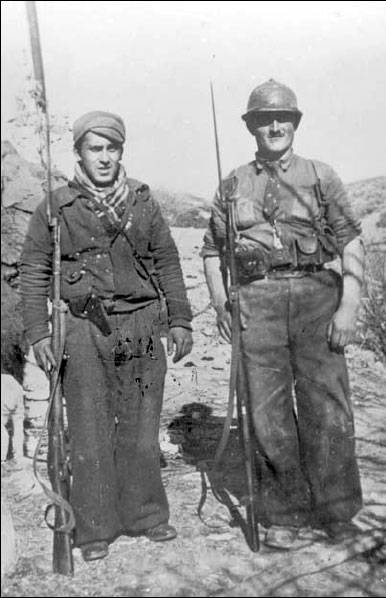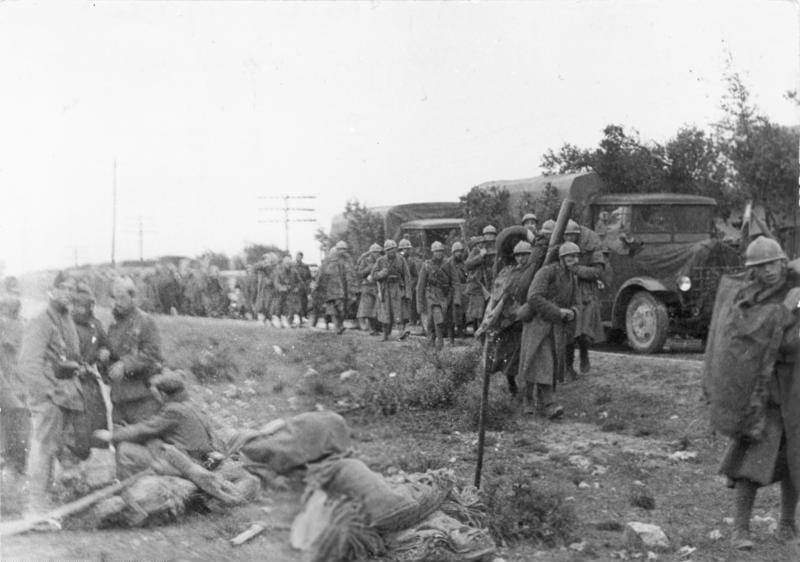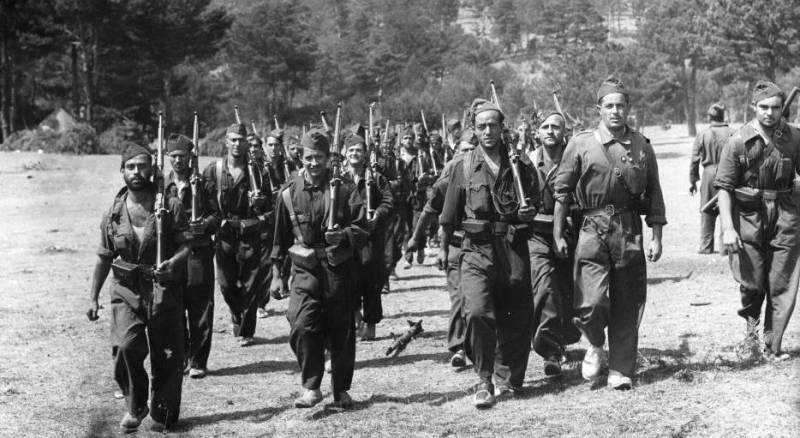Guadalajara defeat of Benito Mussolini. Part of 1
The operation, as we shall see below, showed the enormous importance of the moral factor in the course of hostilities and the skillful interaction of the arms of the armed forces.
Republican people's militia on the march
The Guadalajara sector was quite convenient for the advance of large masses of troops on Madrid - and from the very beginning of the war attracted the attention of opponents. The highway network of the operational area had 5 highways leading from the northeast to the city of Guadalajara. The area where the main events took place during the advance of the Italians (Almadrones, Toriha, Briuega, Macegozo) was a flat 5 defile - 15 km wide, sandwiched on both sides by mountain spurs. The southwestern part of the region (Villaviciosa, Gahapekhos, Trihueke and Briuega) is wooded (a considerable forest area had a great tactical importance, hampering the maneuverability of motorized units). The presence of rokadnyh paths in the forest (Toriha - Briuega - the intersection at 83-th km of the French highway) allowed the Republicans to organize a defense in front of the forest, and secretly maneuver reserves. The open, well-observed terrain to the northeast of the forest prevented Italians from covertly maneuvering. To the south-west of the Thorich-Briueg line were two highways, separated by a roadless mountainous zone.
The Guadalajara sector was defended by the 12th Infantry Division of the Republicans as part of the 72, 50, 71, 49 and 48 brigades, stretched almost on the 80-km front. Owing to such a size of the front, Republicans occupied only commanders of heights and junctions of roads; while the gaps between them were only observed by fasts. In engineering terms, the defense consisted of a single line of trenches (full-length), covered in some areas with a wire fence.

Republican Army Fighters, 1937
On the right flank direction Maranta, Cifuentes defended the 72-i brigade (four battalions). There was no right for the 72-th brigade of the republican troops - because to the southeast, the mountain roadless (almost to Teruel) district excluded the actions of large forces of both sides. Here, individual defiles were covered by small detachments - and the closest detachment in 60 was in Zaorexas.
The central direction along the French Highway was defended by the 50 Brigade: the 3 battalion in positions at the height front of Meranchel, Mirabueno, Castehop and one battalion (recruits without weapons) in Toriha.
The 72-th and 50-brigade brigade covered the cavalry squadron in Las Inviernas.
The 71 Brigade (2-battalion) covered the area of Hadrake.
The Guadalajara-Kogolyudo line was defended by the 49 Brigade, with the 2 battalion in the 1 line, the 3 in reserve in Kogolyudo and the 4 (unarmed) in the rear.
Divisional artillery (15 guns) was in firing positions in the brigade area.
The 48 brigade of the 2 battalion was in reserve - one battalion at Alaminos and the other (without weapons), together with the brigade headquarters - at Briuega.
For the offensive on the Guadalajara direction, the enemy possessed the Italian Expeditionary Corps, which by the beginning of March had finished concentrating in the area of Algor, Sigüens, Medinaceli, Alcolea. In addition, on the front against the 12 division of the Republicans was the Francoist division of Soria (2-brigade), which also had to take part in the offensive.
The Italian Expeditionary Force was a striking force in the operation. In its composition:
a) three Italian volunteer fascist divisions: "God's Will", "Black Flame" and "Black Feathers";
b) personnel Italian motorized division "Littorio";
c) two Italian groups of mixed Italian-Spanish: brigades (each group is equal to a regiment in composition):
d) corps artillery group of eight artillery divisions and four anti-aircraft batteries:
e) special forces: two tank a battalion, a company of armored vehicles, a moto-machine-gun company, two flame-thrower-chemical companies;
e) road maneuvering group (around 1300 vehicles);
g) engineering and communications troops: a sapper company, a radio squadron, a radiotour, a direction-finding unit;
with) aviation;
i) 7 reserve infantry battalions.
70780 (officers - 3150, soldiers - 67630 people) enemy fighters opposed 10000 Republicans (around 6000 active rifles, 15 guns and 85 machine guns).

Italian troops during the Guadalajara operation
Thus, the attacker before the start of the operation had multiple superiority over the defenders.
The plan of the offensive operation of the Italian command provided for 3 successive phases, which were to be developed from 8 to 14 in March.
1-th stage (8 - 9 March) - a breakthrough of the republican defense south-west of Algor and the capture of the area Briuega, Thorich;
2-th stage (10 - 11 March) - the seizure of Guadalajara; at this time the Soria division captures Kogoljudo;
3 Stage (12 - 14 March) - seizing Alcala de Henares (30 km northeast of Madrid) and the punch to Madrid.
The corps offensive was to be conducted in a narrow lane (width 10 - 12 km) along two highways: through Toriha to Guadalajara (French Highway) and Briueg’s turn to Armounia. Naturally, this required a serious grouping of troops. The hull was built in three echelons; in the process of an offensive at certain lines, it was planned to replace one echelon of another
In the 1 echelon, the 2 Volunteer Division was advancing with two groups of mixed brigades and reinforcement units - 15 battalions, 74 guns and 48 tanks. After the 8-minute artillery preparation, this echelon in the morning of March 30 was supposed to break through the Republican defenses on the Mirabueno, French Highway, Las Inviernas section and reach the line Agresilla, Hontanares, Kogolor, Macetoso by the end of the day. After this milestone was reached, the 2 Volunteer Division was to be replaced by units of the 3 Volunteer Division (second echelon).
The 2 echelon consisted of the 3 volunteer division with attached units - 9 battalions, 72 guns, 43 tanks, 32 armored vehicles. After the completion of the Republican defense breakthrough of the 2 division, this echelon was supposed to quickly move forward on vehicles along the French highway and, overtaking parts of the 2 division, capture Thorich.
The 3 echelon consisted of the divisions of Littorio and the 1 volunteer divisions - 16 battalions, 68 guns, 12 tanks. Intended for the further development of success in the direction of Guadalajara, Alcala de Epares.
By the beginning of the offensive, the Expeditionary Corps had its initial position: the 2-I Volunteer Division with reinforcement units deployed on the Mandayon-Navalportto front; The 3 Volunteer Division concentrated around Karabakhos, Alcolea, Aguilar — in readiness at any moment to rush into motor vehicles to develop the breakthrough of the 2 division; The 1 Volunteer Division concentrated in the Sigüenz area; the division “Littorio”, concentrated in the region of Ariza, was to advance to the region of Karabakhos, Alcolea, Aguilar - as soon as the 3-division came out of this region.
Продолжение следует ...

Information